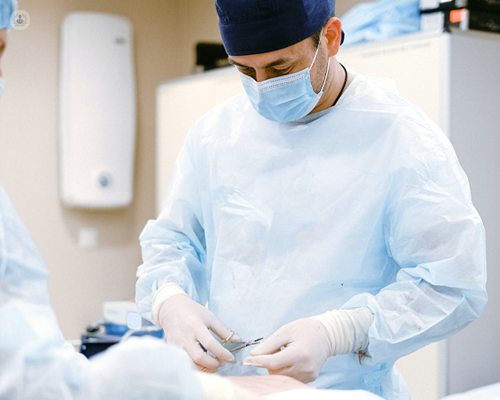An essential guide to epigastric hernia repair
Written by:Patients who are about to undergo epigastric hernia repair may find the thought of having procedure overwhelming, particularly when there are little-to-no other options available but surgery.
While some milder versions of the condition can be left alone, if serious epigastric hernias aren’t treated via surgical action it can lead to severe pain and other severe problems.
Here to provide expert reassurance in this essential guide to epigastric hernia repair is experienced consultant laparoscopic hernia and colorectal surgeon Mr Dominic Coull.

What is an epigastric hernia?
An epigastric hernia is a protrusion of abdominal contents felt as a noticeable lump in the midline between your umbilicus (belly button) and your breast bone (sternum).
What are the benefits of surgery to repair an epigastric hernia?
Surgery is the only cure for an epigastric hernia and it will remove the bulge in your abdominal wall. It should rid you of the associated discomfort. If you are planning to get pregnant, please let your doctor know at your consultation, as this may undo the repair.
Are there alternatives to surgical repair of an epigastric hernia?
An epigastric hernia cannot repair itself, so surgery is the only cure available. It can be left alone, if it isn’t painful and is without significant risk.
What are the possible outcomes if I avoid surgery?
- Increase in size +/- discomfort, especially with a high Body Mass Index (BMI) or chronic cough.
- Possible incarcerated hernia (trapped bowel)
- Possible strangulated hernia (trapped bowel that has lost its’ blood supply and needs emergency surgical removal of devascularised bowel)
- If the trapped bowel perforates, causing peritonitis, both of these conditions can prove fatal.
What does an epigastric hernia repair involve?
Epigastric hernia repair can usually be performed through a small, open incision with minimal discomfort. If the hernia defect is wider than two centimetres, then the repair will usually be reinforced with the insertion of a surgical mesh (not one of the pelvic floors meshes recently seen in the press that has caused lots of concern).
Larger versions may require laparoscopic (keyhole) mesh repair.
Your consultant will also be assessed for a general anaesthetic. You may also need to see an anaesthetist pre-operatively to explore this further, if you have other health issues that may be affected by a general anaesthetic.
You will have a pre-operative appointment with a nurse who will run through a standard list or pre-operative questions with you and usually take some routine blood samples and an ECG (Electrocardiogram).
What happens on the day of surgery?
You will be told in advance a time to arrive, usually 7 to 7.30AM for a morning operation or 12.30 for an afternoon operation. You will be instructed to avoid food and milky drinks for six hours pre-operatively and that you can drink water up to two hours before surgery.
You will be shown to your room by a member of the hospital staff and a nurse will come to admit you.
Your consultant will come and see you and confirm your consent for surgery and check that you have had a chance to ask any questions and understand the possible complications of your operation. He will mark the site of surgery on your body with an indelible marker.
The anaesthetist will also visit you pre-operatively and run through the type of anaesthetic and pain relief that they recommend, as well as alternative options.
Open paraumbilical and umbilical hernia repair
Your consultant will make a small transverse incision through the centre of the defect. This will allow surgical dissection down to the hernia sac which is then excised and the hernia defect is obliterated by suturing the defect. It is then closed with sutures that take three months to re-absorb for added strength of repair. If the hernia is over 2 centimetres in size, then a partially absorbable mesh is sutured into the defect to obliterate it.
The skin will be closed with an absorbable suture just below the surface so it will not be visible and won’t need to be removed.
Surgical glue will be used to seal the wound allowing you to shower or bath from the next day. This will rub off the skin in the next couple of weeks
At the end of the operation, local anaesthetic will be injected. It will last for about five hours and then start to wear off. You should take the prescribed painkillers for your discharge, at regular intervals as instructed, rather than waiting for the discomfort to become too sore.
How can I optimise the chances of my surgery being successful?
- Stopping smoking completely for at least two weeks before surgery will reduce the risk of complications
- Being overweight will increase the risk of complications
- If you are diabetic, keep your blood sugar levels as controlled as possible prior to surgery
- Doing 30 minutes of exercise three-times-a week prior to surgery will improve your ability to cope with the anaesthetic. Don’t do any heavy lifting or exercises which make your hernia pain worse.
To reduce the possibility of a wound infection:
- DO NOT shave or wax the area within seven days of your surgery
- DO have a bath or shower on the day of the operation
- Keep warm on the day of surgery prior to going to the operating theatre
Other tips include:
- Mobilise as comfortable from the day after surgery such as a comfortable walk, without putting excessive strain on the wound.
- You can safely shower or bathe from the day after surgery as your consultant usually applies surgical glue to most wounds.
What are the general complications after this operation?
Bleeding/bruising – Your skin may bruise and turn many colours after surgery such as purple, yellow and grey, but this will usually all resolve within a couple of weeks.
If your wound continues to bleed you should let the hospital staff know.
Pain - Take the analgesia prescribed on your discharge from hospital and if this fails to control your pain, contact the hospital.
Wound infection - If your wound becomes increasingly painful, tender, red or discharges pus, please contact the hospital. Wound infections usually settle with a week of oral antibiotics and rarely requires further surgery.
Blood clots (Deep Vein Thrombosis) - If you develop pain, swelling or redness in your calf or thigh and it has become larger than the opposite side, please contact the hospital. If a Deep Vein Thrombosis (DVT) is present it can move from your leg to your lung (a pulmonary embolism). If you become short of breath, develop chest pain or cough up blood, please contact the hospital or an ambulance urgently.
Scarring - All operations result in some degree of scarring where the incision was made and usually, this fades with time but occasionally it can persist as an unsightly scar. The scar is usually pink for about six months after the surgery and you should use factor 50 sun protection on it during this period.
What are the complications that are specific to epigastric hernia repair?
- Injuries to structures contained within the hernia such as the bowel, are rare
- Swelling with either a collection of fluid (seroma) or blood (haematoma) under the skin. These usually resolve within a few weeks without further intervention.
Recurrence - The hernia can recur in a small percentage of patients which may require another operation.
Mesh infection – These are rare and have never been seen in a patient of mine after this operation. It may require surgical removal of the infected mesh.
Recovery
Patients usually undergo an epigastric hernia repair as a day case procedure (i.e., go home the same day).
- After the general anaesthetic, a responsible adult should accompany you home in a car or taxi and stay with you for 24 hours after your operation.
- Do not drive, operate machinery, cook or sign financial or legal documents for 24 hours after surgery.
- Mobilise from the next day by walking as normally as possible and take painkillers as prescribed, as long as required, to keep on top of any discomfort.
- Most patients take a fortnight off from work. However, they’re able to work from home during that time.
- You can resume sexual activity when comfortable.
- Avoid any heavy lifting until your consultant sees you four weeks after your operation.
Do you need an epigastric hernia repair? Get expert assistance from Mr Coull by arranging an appointment with him via his Top Doctors’ profile


